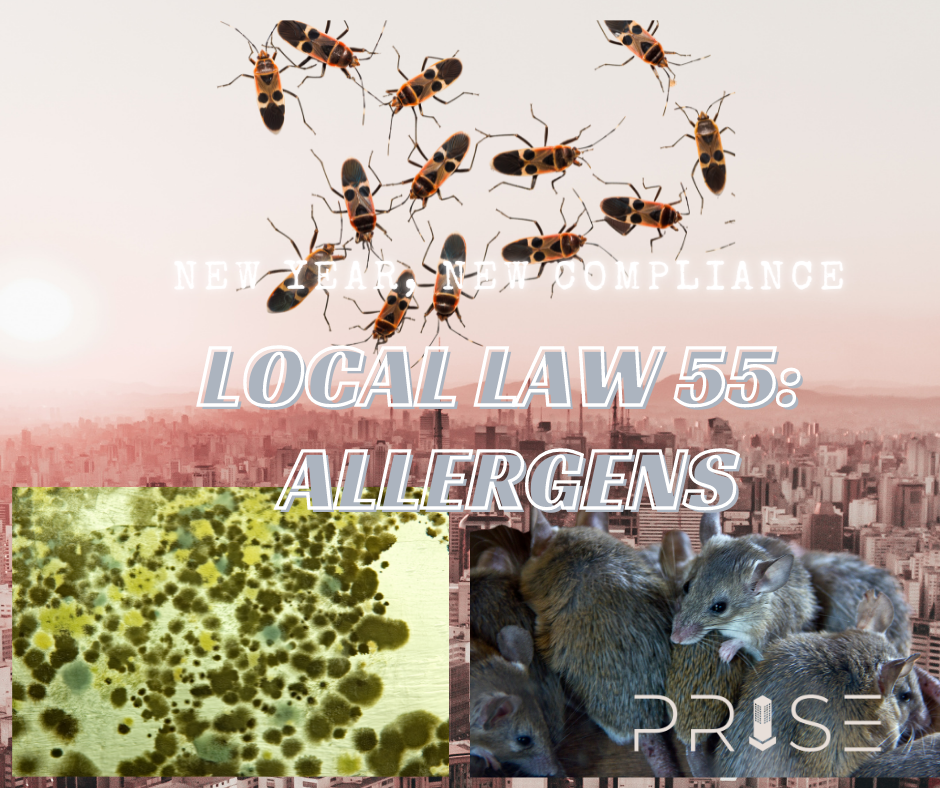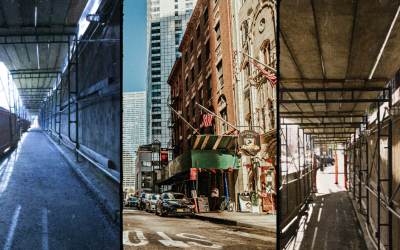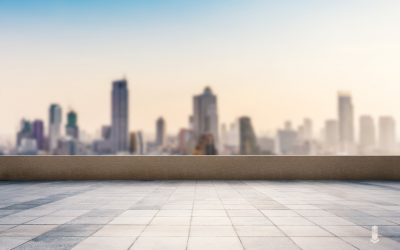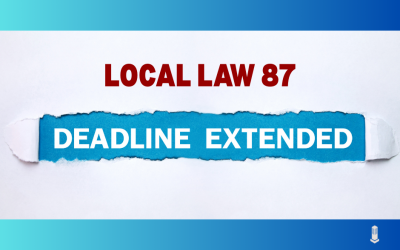
“New Year, New You!”
It’s a mantra repeated by people on countless December 31st’s. Out city is also making significant changes as we enter 2022 that will significantly impact building compliance in the New Year and beyond.
As your compliance experts, Prise is breaking down the Top 5 compliance changes for 2022 daily. This is a breakdown of the big changes coming in 2022 and a little cheat sheet on how you can get can make sure you comply.
Without further ado let’s finish our list with Local Law 55: Allergen Law.
WHAT IS LOCAL LAW 55?
Local Law 55 requires owners of buildings with three or more apartments to keep their tenants’ apartments free of mold and pests.
Owners are required to:
- Annually inspect units for indoor allergen hazards such as mice, cockroaches, rats, and mold, and respond to any complaints received directly from tenants or HPD.
- Make sure vacant apartments are thoroughly cleaned and free of pests and mold before a new tenant moves in.
- Provide the What Tenants and Landlords Should Know About Indoor Allergens and Local Law 55 fact sheet and a Notice with each tenant’s lease that clearly states the property owner’s responsibilities to keep the building free of indoor allergens.
- If mold or vermin are found the owner must remediate.
WHAT DO YOU MEAN BY OWNERS?
Normally, that would be a very weird question, but since Local Law 55 can be fairly nebulous if you manage a condo or coop building. Third-Party Condo and Coop managers are technically not responsible for these inspections. These inspections would fall under the onus of the shareholder or building sponsor if they are renting out units owned by the sponsor.
For rental building landlords, the code is less complicated. Rental properties are required to have all the units in their building inspected.
WHO CAN INSPECT?
Inspection can be done by building staff or a licensed inspector at a cost to the building. These inspections are visual inspections. However, if an excessive amount of mold is found it must be remediated by a licensed mold remediation company.
REMEDIATION OF PESTS
HPD Recommendations taking the following steps to remediate pest infestations:
- Remediate pest infestation. Use Integrated Pest Management (IPM) to address pest infestations. The safe work practices in Section 27-2017.9 of Local Law 55 and 28 Rules of the City of New York section 54-04 must be followed when assessing and correcting any underlying defects (such as moisture) that may have caused the infestation. IPMs requires:
- Removal of pest nests and thorough cleaning of pest waste and other debris by using a HEPA vacuum, washing surfaces, or otherwise collecting and discarding such debris. Make sure to limit the spread of dust when cleaning.
- Elimination of points of entry and passage for pests by repairing and sealing any holes, gaps, or cracks in walls, ceilings, floors, molding, baseboards, around pipes and conduits, and around and within cabinets by using sealants, plaster, cement, wood, escutcheon plates, or other durable material.
- Removal of all sources of water for pests by repairing drains, faucets, and other plumbing materials that accumulate water or leak.
- Attachment of door sweeps to all doors that lead to hallways, basements, or outside.
- Use pesticides sparingly. Pursuant to Administration Code section 27-2017.8 of Local Law 55, any pesticide applied to eradicate the presence of pests must by applied by a pest professional licensed by the New York State Department of Environmental Conservation (DEC).
MOLD REMEDIATION
Mold remediation is required if there are more than 10 square feet of mold found in the unit. HPD requires the following be adhered to in order to remediate the situation:
- Owners of residential properties with 10 or more units are required to hire a New York State Department of Labor-licensed mold assessor and remediator (these two contractors must be completely independent of each other) to assess and remediate conditions whenever there is more than 10 square feet of mold.
- To find a licensed mold contractor in your area, use the NYS Department of Labor’s Licensed Mold Contractors Search Tool. These licensed workers must comply with New York City Administrative Code section 24-154 and New York State Labor Law Article 32.
- Additional information and a portal for the contractors to file required documentation under Local Law 61 of 2018 with the NYC Department of Environmental Protection (DEP) can be found on DEP’s Air Pollution webpage.
- There may be penalties to a property owner for failure to comply with DEP requirements. Copies of these filing receipts are required to be provided to the owner by the contractors after filing, and HPD requires copies of these same documents to be filed with a Certification of Correction for Class B and Class C mold violations issued in buildings with 10 or more units.
For owners who are not required to use professionals as outlined above, whether the removal is completed by a mold remediator or the owner/owner’s representative, safe work practices are required for mold removal. These practices include:
- Removing any standing water, and fixing leaks or moisture conditions.
- Isolating the work area with plastic sheeting and covering egress pathways.
- Limiting the spread of dust. Use methods such as sealing off openings (e.g. doorways, ventilation ducts) and gently misting the molding area with soap and water before cleaning.
- Cleaning mold with soap or detergent and water. Dry the cleaned area completely.
- Removing and discarding materials that cannot be cleaned properly.
- Throwing away all cleaning-related waste in heavy-duty plastic bags.
- Cleaning any visible dust from the work area with wet mops or HEPA vacuums.
- Leaving the work area dry and visibly free from mold, dust, and debris.
VIOLATIONS
If mold or pests are found by an HPD inspector they may issue violations. The following violations may be issued:
|
VIOLATION CLASS |
AREA OF MOLD | PEST PRESENCE |
DAYS TO CORRECT |
|
A |
Less than 10 sq. ft. in a room within a dwelling unit
Less than 30 sq. ft. or 50 sq. ft. in the aggregate in any on level or a hallway or common area |
– |
90 |
|
B |
10 to 29 sq. ft. in a room within a dwelling unit
Equal to or greater than 30 sq. ft. or 50 sq. ft. in the aggregate in any one level or a hallway or common area |
All other pests besides mice, rats, or cockroaches | 30 |
|
C |
Equal to or greater than 30 sq. ft. in a room within a dwelling unit | Mice, rats, or cockroaches in any dwelling unit or common area |
21 |
Property owners are required to correct violations within a specified time frame (see chart above). The dates for Correction and Certification of Correction for violations can be found on the Notice of Violation or through eCertification. The date of Correction can also be found on HPDONLINE.
In accordance with Local Law 55, violations will be upgraded as follows.
Class A violations will be upgraded to a Class B violation, if:
- The mold hazard has not been certified as corrected within the certification time period and HPD has re-inspected the violation within 70 days of the certification period and the condition still exists.
- The Class A violation is falsely certified.
Class B violation will be upgraded to a Class C violation, if:
- The mold hazard has not been certified as corrected within the certification time period and HPD has re-inspected the violation within 70 days of the certification period and the condition still exists.
- The Class B violation is falsely certified.
Only an owner, managing agent, officer of the corporation that owns the property, or party otherwise responsible for the property listed on the property registration may certify correction of the violation.
PRISE ADVICE
Our advice falls into two categories. Owners/Landlords/Rentals advice and Condo/Coop Management advice.
Landlords:
- If you are a landlord or rental buildings make sure you schedule a time at least once during the year to have someone inspect each apartment.
- These inspections can be handled by you directly, building staff designated, or third-party contractor that you have hired
- When you have an apartment turnover, thoroughly inspect and clean the unit to ensure there is no mold or vermin residue
- Keep a log of all inspections at the building for an HPD inspector to review upon request.
Third-Party Condo/Coops:
- Meet with your building’s boards and outline the requirements
- If you choose to have shareholder’s self-police, we recommend that you send them a notice with your annual mailings to help prompt owners to keep track of any issues
- Reach out to the building’s sponsor to ensure any units still owned by the sponsor and rented out to a tenant is being inspected by the sponsor or an agent of the sponsor
- If the board decides to handle inspections on behalf of the entire building, make sure you designate a proper representative to complete the inspections throughout the year
- When shareholders sublet or rent their units to new tenants, ensure that they provide the tenant with the proper documentation on what tenants and landlords should know about indoor allergens.
For more information feel check out Prise’s Local Law Unboxing video in which Prise’s CEO, Adam Batista, “unboxes” Local Law 55 and does a deep dive into the code and its requirements.
Prise is the proactive building compliance specialist. Our team has managed the compliance portfolios for some of the largest luxury management firms in New York City.
To find out more information on Local Law 55 or any other municipal code changes, do not hesitate to email us at info@prisenyc.com or call 212-747-9291, or visit our local law hub online!
https://prisenyc.com/local-law
Keep checking this space for all the latest building compliance news.
Recent Posts
- Major Changes Coming to NYC Facade Inspections, Sidewalk Sheds: What Owners Need to Know
- Understanding NYC’s Annual Parapet Inspection Requirement
- NYC Extends Local Law 87 Deadline to March 2026: What It Means for Building Owners
- NYC Building Compliance Deadlines: Final Quarter 2025 Guide
- NYC Parking Structure Inspections: What Property Owners Need to Know



Recent Comments